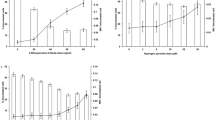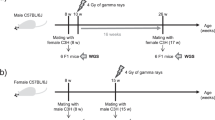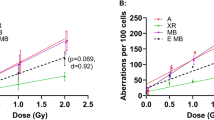Abstract
IT is of interest in this age of radiation hazards to understand more fully the various parameters of mutation and to partition the mutations induced at low levels of radiation from the frequency arising spontaneously. The work recorded here was initiated for this latter purpose and for the following additional reasons: (1) To establish a reliable and quantitative biological system to detect genetic effects at low doses approaching or less than 1 r. (2) Tradescantia was selected as the test organism because its sensitivity is similar to that of human chromosomes1,2. Also Tradescantia has been examined extensively from a radiobiological and biophysical point of view3,4. (3) Spontaneous chromosome breakage, which occurs during meiosis, has been examined under a variety of physiological conditions in Tradescantia5,6. The progeny of these cultures were examined for spontaneous chromosome mutations and the analysis is presented here. (4) Cells irradiated in meiosis were considered most significant to examine from a genetic point of view since the human female ‘stores’ immature ova at meiotic prophase stages, a state of meiotic arrest established in fœtal development7 and maintained throughout reproductive life. Meiotic prophase is known to be the most sensitive stage to radiation during the life-cycle in plants and animals8.
This is a preview of subscription content, access via your institution
Access options
Subscribe to this journal
Receive 51 print issues and online access
$199.00 per year
only $3.90 per issue
Buy this article
- Purchase on Springer Link
- Instant access to full article PDF
Prices may be subject to local taxes which are calculated during checkout
Similar content being viewed by others
References
Bender, M. A., and Wolff, S., Amer. Nat., 95, 39 (1961).
Chu, E. H. Y., Giles, N. H., and Passano, K., Proc. U.S. Nat. Acad. Sci., 47, 830 (1961).
Sax, K., Quart. Rev. Biol., 32, 15 (1957).
Lea, D. E., Action of Radiations on Living Cells (Macmillan Co., New York, 1947).
Steffensen, D. M., Brookhaven Symp. Biol. 12, 103 (1959).
Steffensen, D. M., Intern. Rev. Cytol., 12, 163 (1961).
Ohno, S., Klinger, H. P., and Atkin, N. B., Cytogenetics, 1, 42 (1962).
Sparrow, A. H., Ann. New York Acad. Sci., 51, 1508 (1951).
Rep. U.N. Sci. Comm. Effects of Atomic Radiation, General Assembly, Thirteenth Session, Supp. 17 (New York, 1958).
Author information
Authors and Affiliations
Rights and permissions
About this article
Cite this article
STEFFENSEN, D. Chromosome Aberrations arising spontaneously and induced in Meiotic Cells at Low Levels of Radiation in Tradescantia. Nature 201, 205–206 (1964). https://doi.org/10.1038/201205a0
Issue Date:
DOI: https://doi.org/10.1038/201205a0
This article is cited by
Comments
By submitting a comment you agree to abide by our Terms and Community Guidelines. If you find something abusive or that does not comply with our terms or guidelines please flag it as inappropriate.



